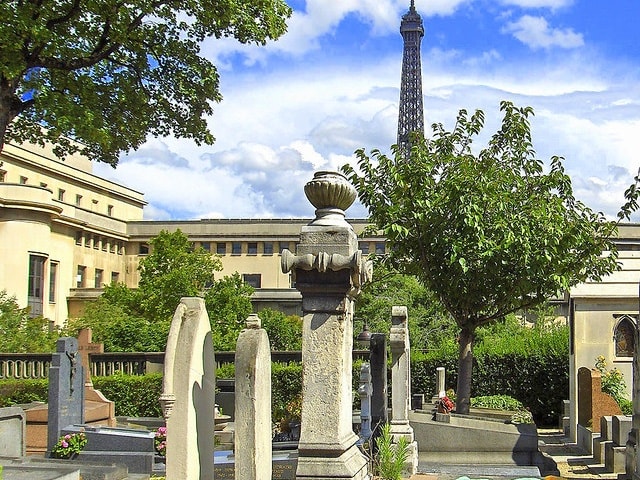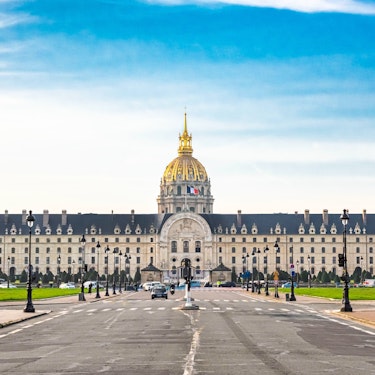More about: The 10 Most Famous Cemeteries in Paris
Cemetery tourism attracts millions of travellers around the world. The French capital is also famous for its graves, so much so that National Geographic has included two cemeteries in its list of the 12 best in the world.
The chosen ones are the famous Père Lachaise and Montmartre cemeteries, but there is much more to discover. If you are looking for things to see and do in Paris, this article will help you plan your holiday.
1. Père Lachaise Cemetery

Probably the most famous cemetery in the world. Its construction was a consequence of the Edict of Saint Cloud, an ordinance that provided for the burial of corpses outside the city walls. In fact, at the beginning of the 19th century, this peaceful graveyard was located a few kilometres from the city centre.
Year after year - and not without a few difficulties - the cemetery has welcomed both famous and ordinary people. The most famous grave is that of Jim Morrison, who died in Paris in 1971. However, it is not the only one worth seeing:
- Fryderyk Chopin, the Polish musician (except for his heart, which is in Warsaw), rests in Père Lachaise. A sculpture of a weeping muse watches over the site.
- Georges Rodenbach, a Belgian poet and novelist who settled in the French capital. His tomb depicts Rodenbach himself emerging from a large block of granite
- Oscar Wilde, the mausoleum was designed by Jacob Epstein and depicts a winged figure, probably inspired by the poem "The Sphinx Without a Secret".
To discover the other tombs, it is worth booking a guided tour with an expert who will take you on a tour lasting just over two hours and explain each of the secrets of the place.
After a good walk around the cemetery, it is normal to feel a little hungry. In this case, I recommend booking a table at Bistrot Père (10 Avenue du Père Lachaise).
- Price: between €30 and €60
- How to get there: the nearest underground stations are Gambetta (lines 3 and 3B), Père Lachaise (lines 2 and 3) and Philippe Auguste (line 2)
2. Montparnasse Cemetery

Montparnasse is one of the best neighbourhoods in Paris. It was once the epicentre of artistic life and is now recommended both for accommodation and nightlife.
There are dozens of charming bars and restaurants such as Le Barbylone (famous for its craft beers) and Hardware Société (a Mecca for brunch lovers).
However, most tourists come here to visit the cemetery of the same name. Opened in 1824, it is a veritable open-air museum, as many of the tombs have been listed as Historic Monuments.
It stretches from Montparnasse train station to Denfert-Rochereau square and is divided into two parts: Petit-Cimetière and Grand-Cimetière. The most famous tombs are those of Charles Baudelaire, André Citroën, Jean-Paul Sartre and Samuel Beckett, although the list could be longer.
- Price: admission is free
- How to get there: the cemetery is surrounded by the Raspail (lines 4 and 6), Edgar Quinet (line 6), Denfert-Rochereau (lines 4 and 6) and Gaîté (line 13) underground stations
If you like the macabre and want to spend a scary night in Paris, don't miss the night-time ghost tour, where you'll hear all the legends and gruesome stories hidden in its streets.
3. Passy Cemetery

This tiny cemetery is home to the graves of 19th-century aristocrats, industrialists and artists. A stroll through the graveyard will give you the opportunity to enjoy the silhouette of the Eiffel Tower and the tombs of Marcel Renault (racing driver and founder of the company of the same name), musician Claude Debussy, impressionist painter Édouard Manet and Bảo Đại, the last emperor of Vietnam.
To enter, you must pass through the monumental entrance gate and the reception pavilion (pavillon d'accueil) designed by architect René Berger in the early 1930s. If you want to plan your route in advance, you can download the map from the official website.
- Price: admission is free
- How to get there: the cemetery is located near the Trocadero Gardens, just opposite the Eiffel Tower in Paris. The nearest metro stop is Trocadéro (lines 6 and 9).
4. Montmartre Cemetery

No stay in Paris is complete without a stroll through Montmartre. When the French capital was the art capital of the world, artists of the calibre of Degas, Van Gogh and Picasso used to walk here. Its most visited monument is the Sacré Coeur Basilica, closely followed by the neighbourhood cemetery.
Like its cousin, the Père-Lachaise cemetery, it is known for being a romantic oasis within the city. Its most famous graves are those of film director François Truffaut, writer Alexandre Dumas and impressionist painter Edgar Degas.
With its cobbled streets and historic cafés, Montmartre is the ultimate romantic destination. To find out everything there is to do, I recommend reading the article that explains what to see and do in Montmartre.
- Price: free
- How to get there: the nearest metro stops are La Fourche (line 13), Blanche (line 2) and Place de Clichy (lines 2 and 13)
5. Picpus Cemetery

Although not one of the most famous cemeteries, it is definitely worth a visit. Its origins are linked to the French Revolution and the subsequent period of terror. It is estimated that between 16,000 and 40,000 people were executed and their remains ended up in the Picpus cemetery.
Today it is a private cemetery and only the descendants of the victims of the Terror can be buried here. The most visited tomb is that of the Marquis de La Fayette, a military man, politician and staunch defender of democratic principles.
He played a crucial role in the creation of the United States and his grave is a destination for many American tourists.
If you decide to venture away from the centre to visit this area of Paris, you can take the opportunity to see the monumental Place de la Nation, admire the trompe l'oeil "Fresque La Serre" (Rue de Reuilly) or play a game of billiards at the famous Billard Nation Shoot Again (Cité Debergue 9).
- Price: admission to the cemetery costs around €2.
- How to get there: the cemetery is located near the Bel-Air and Picpus metro stations, both on line 6
6. Batignolles Cemetery

Although it is the final resting place of André Breton and Paul Verlaine, it is not very well known and few tourists visit it. The cemetery borders one of the city's noisiest and busiest ring roads, the Boulevard Périphérique, but even this thoroughfare cannot detract from its charm.
Until the 1970s, it was the burial place of the Russian community in the French capital. For this reason, in one corner of the cemetery is the tomb of Léon Bakst, a painter and set designer who designed splendid costumes for the Opéra Garnier in Paris.
- Price: free
- How to get there: the entrance is a short distance from Porte de Clichy, a station on metro lines 13 and 14 and the RER C railway line
7. Panthéon and its crypt

A neoclassical building designed by architect Jacques-Germain Soufflot. When he was commissioned by the "Sun King", the monarch asked him to design a large church dedicated to the patron saint of Paris: Saint Genevieve. Its high dome and portico of Corinthian columns reveal its original use.
Everything changed after the French Revolution. With the change of regime, this great temple became the burial place of the most famous French people. Here lie the remains of Émile Zola, Voltaire, Marie Curie and other important figures.
By the way, if you want to know more about this historical period, you can visit the Musée Carnavalet, which has a collection of objects used during the revolutionary period (Rue de Sévigné 23).
- Price: a standard ticket costs around €11. If you want to include the climb to the panoramic viewpoint, you will have to pay around €15.
- How to get there: the most convenient metro stop is Cardinal Lemoine (line 10).
8. Paris Catacombs

In the 18th century, there was no place left in Paris to bury the dead. To deal with the emergency, the authorities decided to transfer the bones from the mass graves to the underground quarries hidden between the banks of the Seine and the city centre.
The first visits took place at the end of the 19th century and more than 100 years later they continue to attract tourists. Before descending into the bowels of the capital, a sign warns "Arrête! C'est ici l'empire de la mort" (Stop! This is the empire of death). The tours are very evocative and last between one and two hours.
The meeting point for the tours is usually Avenue du Colonel Henri Rol-Tanguy. For more information, I recommend reading the article on visits to the catacombs of Paris.
- Price: between €30 and €80
- How to get there: the nearest metro stop is Denfert-Rochereau (lines 4 and 6)
9. Napoleon's tomb at Les Invalides

After commissioning the construction of the monumental Palace of Versailles, Louis XIV of France, nicknamed the "Sun King", ordered the construction of the Hôtel des Invalides. Initially, this structure provided accommodation and hospital care for soldiers wounded in battle.
It is not a real cemetery, yet it houses the remains of the most famous Frenchman in the world: Napoleon Bonaparte. Twenty-one years after his death, the emperor returned to Paris for the last time and has since rested in a large red quartzite sarcophagus.
In addition to the tomb, the structure houses the Army Museum and the Museum of Relief Maps. To deepen your knowledge, I recommend reading the post about visits to the Invalides Museum and Napoleon's tomb.
- Price: an adult ticket costs around €15. European Union citizens under the age of 25 enter free of charge.
- How to get there: the nearest metro stop is Invalides (lines 8 and 13).
10. Tomb of the Unknown Soldier

During the First World War, France lost 1.5 million men. These soldiers died in the gruelling trench warfare that mainly took place on the eastern front with Germany. After the conflict, the authorities decided to erect a monument beneath the Arc de Triomphe.
The Tomb of the Unknown Soldier is a tribute to an anonymous French soldier who died in the terrible Battle of Verdun. An eternal flame pays tribute to the nameless victims of all wars.
- Price: free
- How to get there: the nearest metro stops are Kléber (line 6) and Argentine (line 1)
Can they be visited at night?

Sorry, cemeteries are not usually open after sunset. If you want to do something like this, you can opt for a night cruise on the Seine, a walking tour of the old town or an excursion to Montmartre in a Citroën 2CV.
Other popular options include private tours by Segway, bicycle or hop-on/hop-off bus. For more information, I recommend reading the article that explains everything you need to know about visiting Paris at night.




















